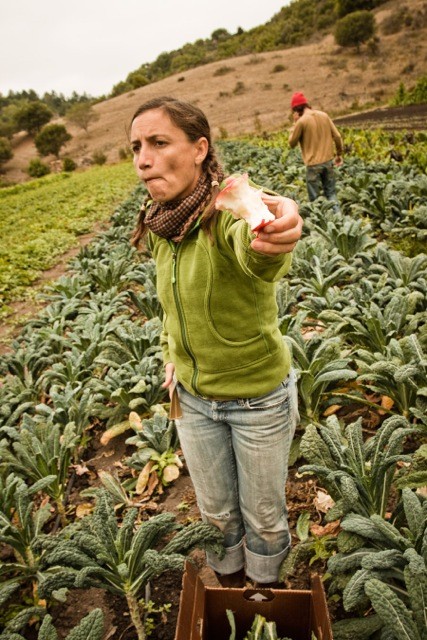
Olivia Tincani is our guest blogger this week. She began her path to resistance in her father’s tomato garden in California and her uncle’s vineyard in Italy. Olivia was the managing partner of Farm 255, a unique “farm-AND-table” operation in Athens, Georgia, founded in 2005, that grew much of its produce on its own farm, Full Moon Farms. With her partners, she also opened Farm Burger in nearby Atlanta, serving 100% local grass-fed burgers sourced entirely from their Moonshine Meats collective, a pasture-based producers cooperative that supplies grass-fed beef for four restaurants with a whole-animal mentality. She has also worked as a community organizer for grassroots networks and non-profit organizations such as Slow Food International, The National Young Farmers Coalition, and The Greenhorns. She is currently a Partner for food business consultancy Fare Resources as well as Communications Director for Llano Seco Organic Meats. Olivia lives nomadically between the US and Italy, working with clients in every locale, and double-digging her father’s garden on her days off.
The Marriage of Meat & Tech
Meat and technology, or rather science, as it used to be called, have been friends forever. Even before Upton Sinclair exposed Chicago’s food-unsafe stockyard shenanigans in The Jungle, which directly led to the landmark Meat Inspection Act of 1906, meat and science knew each other well. The Homestead Act of 1862 gave rise to more family farms, and together with industrial revolution developments such as the refrigerated boxcar, efficient profit- rather than subsistence-based animal husbandry was encouraged and practical for the first time. Buffalo, deer, elk went out and cattle, sheep, pigs and oxen stampeded in. British researchers J.B. Lawes and J.H. Gilbert reported the influence of “fattening” on the composition of domesticated 4-leggeds in 1860, one of the main qualifiers we still use today as criteria for evaluating animal husbandry tactics. Thanks to the state-sponsored land-grant university system that declared a national priority to teach agriculture, the first meat laboratory was established in 1900 at the University of Minnesota.
And now? Now we have graduated to a petri-dish procured hamburger patty. Dairy cows have microchips implanted in their ear tags to measure the quantity of milk they produce, and each Bessie’s personal lactation log is transferred via Bluetooth to a digital LED screen mounted to the back of the stall gate. We not only hack computer operating systems but we also hack meat. The Silicon Valley Start-up Moguls have decided to flaunt their fancy for risk-based investments by backing food startups. There are whole animal buying programs inside of billionaire gaming company mess halls, streamlined online ordering and delivery systems that re-imagine the distribution supply chain from cut floor to case, cowsharing social sites, and app-based meat and food anything. I feel as though we food professionals in the Bay Area are sitting in the front row of the fast and fluttering wedding of food and technology, nervously clutching our programs and fanning our hand-hewn hide-skin fans as we observe the two industries promise so much to each other, so quickly. I am personally thrilled to be in a position to not just watch but partake in the exciting new union.
Alongside all this technology, butchers–like these noble folks at The Local Butcher Shop–are back in style, and beautifully so. Armed not with code, nor angel funding, butchers still count band saws and boning knives as the most valuable tools in their arsenals. Raw material (meat) meets raw material (steel) over and over again with each carcass, each day. I think it’s curious that we arch backwards and rejuvenate this craft as we simultaneously stretch forward into the future as meat /food innovation tries to keep pace with tech, and so far, basically succeeds. But even the new old school butchers log store sales on Square gizmos attached to their IPads. They employ new fangled gadgets to track the temperature and humidity of their handcrafted salumi that hangs in converted home refrigerators all jacked up with….technology.
It all leads me to ask why, why did meat attract tech? Because both value and depend on innovation to progress as industries. And because meat is still the frontline of the fierce and unforgiving sustainable food fight. If we can conquer how to safely, humanely, responsibly and ethically raise, slaughter, cut, sell and eat meat, well then… we WIN. And we will most assuredly need technology at our back, in our pockets and our knife sheaths, to get us there. Let the honeymoon begin.

Leave a Comment